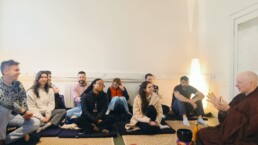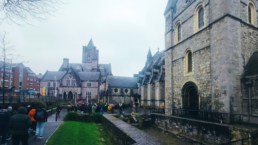Day Two: Bridging the Divides in Dublin’s Minority Faiths
DUBLIN - After a hearty buffet breakfast of sausages, potatoes, eggs and black and white pudding, we convened in the lobby at 8:45 a.m. – on the dot, as Greg Khalil, our professor, had hammered into our heads the night before. Ian Bermingham, our tour guide from yesterday, was already there in his tweed coat, green Doc Martens and newsboy hat, ready to guide us through the last three centuries of Irish history while strolling through Dublin.
"Who Said We Never Had an Empire?"
Bermingham greeted us with the same energetic excitement and witty jokes as yesterday, brightening another gray, misty morning. He led us to Dublin’s General Post Office, where we learned about the 1916 Easter Rising—when Irish nationalists, including an all-female paramilitary group, seized the GPO and other government buildings in an armed insurrection and proclaimed the Irish Republic. The rebellion lasted for six days before being suppressed by the British Army, but it reawakened a thirst for Irish Independence.
We stopped on the O’Connell Bridge overlooking the River Liffey, which geographically separates the city into North Dublin and South Dublin. It was also the subject of Bermingham’s “most boring fact”—the bridge is wider than it is long.
He talked to us next about the Great Famine, also called the Irish Potato Famine. In typical Bermingham fashion, he narrated a horrifying historic event in a way that was thorough and peppered with humorous quips and fist bumps as a prize to those of us answering his questions.

He shared that the famine was so devastating in part because of the Irish government’s response to the crisis. The Irish government did not provide any government assistance, more concerned about establishing a welfare state than its starving citizens. Potatoes were a cash crop, so when food ran out and farmers had to resort to eating their own crops, they incurred a significant financial loss and could not afford to pay rent. As a result, many Irish people were evicted by their landlords or forced to emigrate to another country. The Irish Potato Famine was a tragedy, resulting in about a million deaths. Bermingham explained that it is also the reason why Irish culture made its way across the globe. More than 70 million people worldwide have Irish ancestry, and about half of them live in the United States.
“That's why the grass is so green in Ireland; we are off walking on your grass,” Bermingham said, throwing his head back in a roaring laugh. “Wherever you're from, is there not an Irish pub in your town? Do you not celebrate St. Patrick's Day?” he questioned. “Who said we never had an empire?”
Enquiry at the Buddhist Zen Centre

Yesterday, we ventured to Dublin’s Temple Bar District for a lunchtime Guinness and our first taste of Irish pub culture. Today, we returned to the District for a very different purpose: to visit the Dublin Zen Centre and meet Zen Buddhist priest Ian Kilroy.
We passed through an unassuming door beside a tattoo parlor and scaled a steep set of stairs. As we entered the two-roomed Centre, which Kilroy revealed used to be a solicitor’s office, we took our shoes off and settled onto meditation cushions. Our group of 20 sat cross-legged in silence as we observed Kilroy tie his brown robe and light two types of incense, a stick and a powder, at the altar. Later, he told us they represent the two aspects of reality: the stick of incense represents the subjective, and the powdered incense represents the universal aspect of us, our “innate oneness.” Kilroy struck a singing bowl, and we sat in stillness, our eyes closed, the sounds of Dublin filtering in through the two windows and the smell of incense wafting through the air.
Unlike some Buddhists who stay away from politics, Kilroy considers himself an activist of sorts. He described the discrimination that often comes along with living as a religious minority in Ireland. In one instance, his son was denied acceptance to a Catholic school when Kilroy marked his spouse and himself as identifying with “no religion.” When he threatened legal action, the school asked him to reapply. This time, he marked himself as “baptized Catholic,” and his son was accepted.
“It is a residue of discrimination that should be addressed,” Kilroy explained, “but it persists and is ignored.”
For example, there are only Catholic and Protestant chaplains at hospitals and schools. Kilroy’s efforts for more representation of other faiths have failed time and again. He spoke critically of the country’s systemic prejudice against families who are not followers of its two most practiced religions.
“We are locked into a binary imagination,” he said.
But he said he has hope because of organizations like Dublin City Interfaith Forum, which put together a list of people you can ring if you need a rabbi or Buddhist priest since chaplains aren’t available. It also encourages conversations among individuals with different backgrounds — something we as journalists have tried to achieve in our time in the religiously diverse Dublin.
A former journalist himself, Kilroy advised us to remember in our reporting that religions are made up of individuals.
“We tend to think that religions are free-floating sets of doctrines,” he said. “But in fact they’re lived by people.”
An Afternoon of Reporting
Emerging from the peaceful Zen center, our class dispersed for an afternoon of independent reporting and wandering.
Renata Carlos Daou spent the afternoon visiting three historic cathedrals: St. Patrick’s Cathedral, Whitefriar Street Church and Christ Church Cathedral. She observed services in the first two and a choir performance in the third, seeking to understand how these traditional Church of Ireland ceremonies differed from others.
One of Sam Shepherd’s sources invited him on a private LGBTQ+ walking tour of Dublin who told him stories about the former criminalization of homosexuality and a series of murders of Queer men in the 1980s that the government ignored, giving rise to Ireland’s first Pride Festival in 1993.
In search of murals painted in solidarity with Palestinians in Gaza, Meghnad Bose found a heart-wrenching image of Palestinian journalist Samia al-Atrash holding her niece Masa’s lifeless body in her arms. He shared a photograph of the mural on his Instagram. To his surprise, al-Atrash responded with a Palestinian flag and a broken heart emoji.
Others spent the afternoon wandering the cobblestone streets of central Dublin, visiting museums, exploring Trinity College’s campus or catching up on rest.
Stay tuned for these pieces in the weeks to come!
Iftar at the Islamic Cultural Center
We reconvened in the hotel lobby at 5 p.m. and climbed onto a bus, which lumbered out of the city center and into the suburbs. Today was the first day of Ramadan, and we were invited to observe iftar — or the breaking of the fast at sunset — at the Islamic Cultural Center of Ireland. At 6:24, the sun set, and while the call to prayer rang through the room, dozens of men and children took their seats on the floor, shoulder to shoulder, and broke their fast in unison with dates, water and milk.
Imam Ali Selim gave us an overview of Muslim life in Ireland over dinner: lentil soup and a heavy portion of Biryani and lamb. Even though Selim hadn’t eaten all day, he insisted on serving us before himself and exemplified generous hospitality. Salim ended the meal with a beautiful message of unity. “We are all brothers and sisters in humanity,” he said. “We may have different faiths, but that is for God to judge.”
Edited by Trisha Mukherjee
Day One: Discovering Dublin’s History, Cuisine and Quirks
DUBLIN — We landed in Ireland at about 7 a.m. Sunday and were greeted by typical Irish fog and a spraying of light rain. Though the class was low on sleep, spirits were high. We experienced a momentary scare when half the group was trapped in an airport elevator. But the luck of the Irish prevailed, and we all safely exited the Dublin Airport and dropped our luggage at the Gresham Hotel.
We began our day with a walking tour of the city, led by local expert and musician Ian Bermingham, whose quick-witted historical anecdotes revived and energized our jet-lagged group. Our first stop was Dublin’s General Post Office, where Bermingham pointed out the bullet holes on the columns — a reminder of the violent price of independence that the Irish established in 1921.
We then climbed the narrow, steep staircase into the Old Mill Restaurant in the Temple Bar neighborhood, where we enjoyed a traditional Irish breakfast of fried eggs, sausage and toast. Also on the plate were small pucks of black and white puddings — a local favorite of oats mixed with blood and animal fat, respectively — that received mixed reviews from those brave enough to taste it. These reporters opted out.
On our way there, the streets had been quiet. Bermingham had warned us that in a couple of hours, the bars would be thronged with tourists hoping to hear musicians and enjoy an authentic Guinness pint. He was right. The restaurant filled up while we were eating, forcing us to squeeze past a line of incoming diners as we exited down the stairs, and we found the square outside already bustling by 10 a.m.
After breakfast, we walked up a small pebbly incline and learned we had mounted the highest point in Dublin. There, we stopped to learn the history of Dublin Castle, which Bermingham explained had been damaged in an explosion hundreds of years ago. Red brick office buildings are now where that tower once stood.
As we continued our tour, a common theme began to appear: Vikings. Tour buses with foreigners donned in Viking wigs and helmets passed by, and they all screamed in unison at their guide’s instruction. Outside of the cathedral, Bermingham showed us plaques that commemorated Viking artifacts discovered at different locations in the city. There were even outlines of Viking homes that were erected centuries ago, giving us just a bit of insight into what life was like in Dublin then.
We also got to walk through the grounds of Christ Church Cathedral, a historic Church of Ireland. The grounds were busy as tourist groups stood to marvel at the old stone architecture.
It started to rain more as the afternoon progressed, so we stopped to warm up at the Temple Bar Pub where we ordered Guinnesses and Irish coffees. A popular destination, the pub was filled with cheerful tourists and live Irish folk music.
“It’s a nice place, but you won’t hear too many Dublin accents in there,” said Bermingham.
After getting some much needed rest at the hotel, the class rallied for a fantastic, modern Irish farm-to-table dinner at The Woollen Mills Eating House. Favorites included the Irish-spiced burrata, fresh pan seared sirloin and a rich chocolate brownie topped with vanilla ice cream.
While at dinner, each student relayed one thing that surprised them about Dublin. One thing that stood out to multiple students was a plaque on the O’Connell Bridge. It reads:
“THIS PLAQUE COMMEMORATES
FR. PAT NOISE
ADVISOR TO PEADAR CLANCEY.
HE DIED UNDER SUSPICIOUS
CIRCUMSTANCES WHEN HIS
CARRIAGE PLUNGED INTO THE
LIFFEY ON AUGUST 10TH 1919.”
But we learned Noise never existed, and the origin of the story is still unknown. (Always fact-check when an Irish person uses the disclaimer “allegedly,” Bermingham jokingly warned us.) Even so, the plaque had become popular with locals, who often left flowers around it. The city’s initial effort to remove it was rebuked by Councillor Dermot Lacey in 2006 at a meeting for the South East Area Committee of the Council. The Council approved a motion supporting keeping it despite its inauthenticity — instead commemorating the Irish passion for a good story.
Edited by Natalie Demaree


